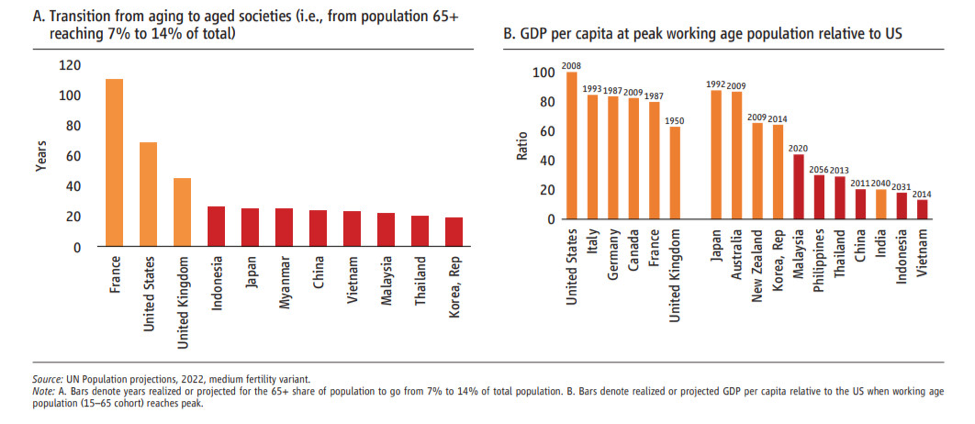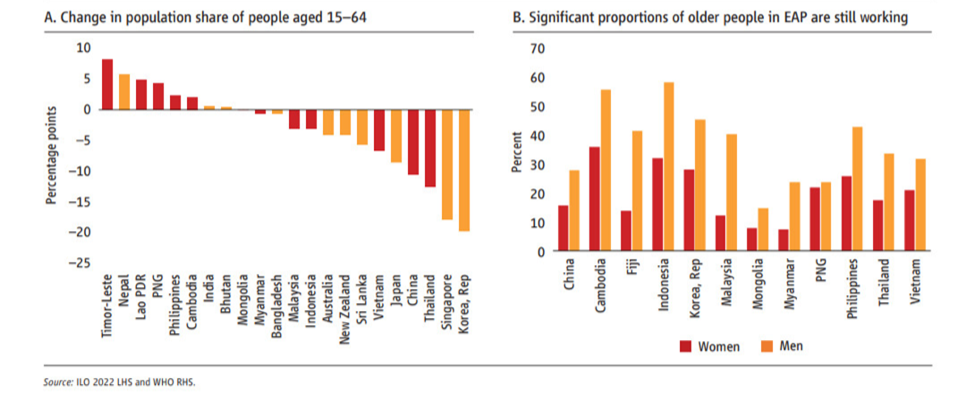While population aging has been recognized as a longstanding concern for European and American nations, it is now emerging as a formidable challenge for populations across Asian countries, notably in the East Asia and Pacific region.
According to UNFPA Vietnam, Vietnam is one of the countries with the fastest population aging rates in the world. People aged 60 and above accounted for 11.9% of the total population in 2019, and by 2050, this figure is projected to increase to over 25%.
The situation of population aging in the East Asia and Pacific region.
The phenomenon of “population aging” or the stage of an “aging population” as officially defined by the United Nations, occurs when the proportion of a nation’s population aged 65 and over exceeds 7% of the total demographic. When this percentage escalates beyond 14% and 20%, the population is categorized as “aged” and “hyper-aged” respectively. The United Nations Population Fund (UNFPA), however, adopts a benchmark of 60 years of age instead of 65, with corresponding proportions of 10%, 20%, and 30% to denote the conditions of “aging”, “aged”, and “hyper-aged”.
According to the April 2023 East Asia and Pacific Economic Update report recently released by the World Bank (WB), most emerging economies in this region have recovered from recent shocks and are growing. However, alongside economic achievements, the East Asia-Pacific region also faces the challenge of a rapidly aging population at a lower income level compared to European and Central Asian (ECA) and OECD countries that are currently older but wealthier. The transition phase from an aging society to an aged one (meaning the population in the 65+ age group increases from 7% to 14% of the total population) in most East Asian and Pacific countries only takes place within 20-25 years, compared to 50-100+ years in the aforementioned countries.
Moreover, East Asia-Pacific countries are also becoming aged societies with significantly lower income levels than OECD countries, where the GDP per capita at purchasing power parity of the working-age population peaks at only 10% to 40% of the United States, at the same time of demographic transition.
Figure 1: East Asia and Pacific (EAP) Countries are aging faster than rich countries did, and the working age population will peak at lower levels of income per capita

Additionally, as per the data shared by the World Bank (WB), the phenomenon of aging partially originates from the rapid economic development in the region over the past few decades. Increased income and higher education levels have consistently extended life expectancy and concurrently led to a sharp decline in fertility rates. This has resulted in a situation where the rate of new additions falls significantly short of the decrement rate in some countries.
Therefore, by 2060, every five nations with the oldest populations in the world, there will be one country from the East Asia region, while this ratio was only one in 25 in 2010.
The challenges posed by population aging to the labor market and economic growth.
The issue that countries are concerned about is the aging population, which is having serious impacts on the labor market and the overall economic development of countries. Rapid population aging could also lead to future labor shortages, raising questions about its effect on labor supply and long-term productivity growth.
For an economy, a significant increase in the working-age population is a positive development. There will be more workers generating income to support the elderly and children. As long as the labor market can absorb the increasing number of people seeking employment, GDP per capita will rise.
In contrast, when the proportion of the working-age population in the 65+ age group exceeds 14% of the total population, it impacts the structure of the labor force, and consequently, economic growth and development.
An aging population can affect economic growth as the proportion of the population in the working age (usually the 15-64 age group) decreases.
Figure 2: Aging could reduce the share of the conventional “working age” population, unless older people (especially women) continue to work

Finding a solution to the aging population issue.
The labor force is one of the crucial factors that help governments achieve their economic growth and development goals. The aging population has been and continues to exacerbate the issue of labor force shortages. This poses many challenges for governments in finding additional labor resources to meet the economy’s labor demands to maintain growth and development.
Unlike previous decades, globalization has turned labor supply shortages into a global issue. Some Eastern European countries have witnessed labor force migration to countries such as Germany, France, and Italy in search of better job opportunities in places lacking labor forces. In other words, labor shortages in one group of countries will be shared by another group of countries, under the influence of globalization.
Population aging is a global phenomenon and part of the significant changes taking place worldwide. Between 2015 and 2050, the estimated number of elderly people aged 65 and over worldwide is expected to rise from 703 million to about 1.5 billion, accounting for 15.5% of the global population. Therefore, population aging certainly requires the close attention of policymakers, with decisions based on a lifecycle approach. While population aging poses challenges for society and the economy, appropriate policies will allow individuals, businesses, and society to address these challenges and reap the benefits it brings.

Addressing the challenges of population aging requires strategic policy interventions. Governments must grapple with the complexities of labor shortages, exploring global solutions in a world increasingly interconnected by globalization. The scale of population aging is not limited to the East Asia-Pacific region but is a global phenomenon. Policymakers worldwide must adopt a lifecycle approach to address the profound changes unfolding and make decisions that benefit individuals, organizations, and societies. The next part, we will delve deeper into the macro-level approach to comprehensive strategies in Vietnam and the Asia-Pacific region.
According to the “Research and Analysis of Labor Market and Economic Growth Facing the Challenge of Population Aging – Part 1” by Tuyen Le, Head of Market Intelligence.

Head of Market Intelligence, PeopleWise Vietnam.
As a Ph.D. Student, Research in Economics, Tuyen Le provides market insights, industry trends, and research on labor and workforce effectiveness. Through her research and analysis, she helps business leaders identify potential risks and threats to their businesses and industries, allowing them to take preemptive measures and invest with calculated risks and outcomes.

